Smart Home Application Project Report - BSc (Hons) in Your Programme
VerifiedAdded on 2022/09/08
|63
|11563
|11
Project
AI Summary
This project report details the development of a smart home application, undertaken as part of a BSc (Hons) degree in Engineering and Computing. The project focuses on creating a system that allows for remote control and monitoring of home devices via a smartphone application. The report covers all stages of the project lifecycle, from initial problem definition and literature review to system design, implementation, testing, and ethical considerations. Key technologies explored include Arduino or Raspberry Pi microcontrollers, Android mobile application development, and the Internet of Things (IoT). The project aims to address the limitations of manual home operation by automating tasks such as lighting control, security, and electrical device management. The report also includes discussions on the proposed solution, methodology, results, conclusions, and recommendations for future work, offering a comprehensive overview of the smart home application development process and its potential benefits for homeowners.
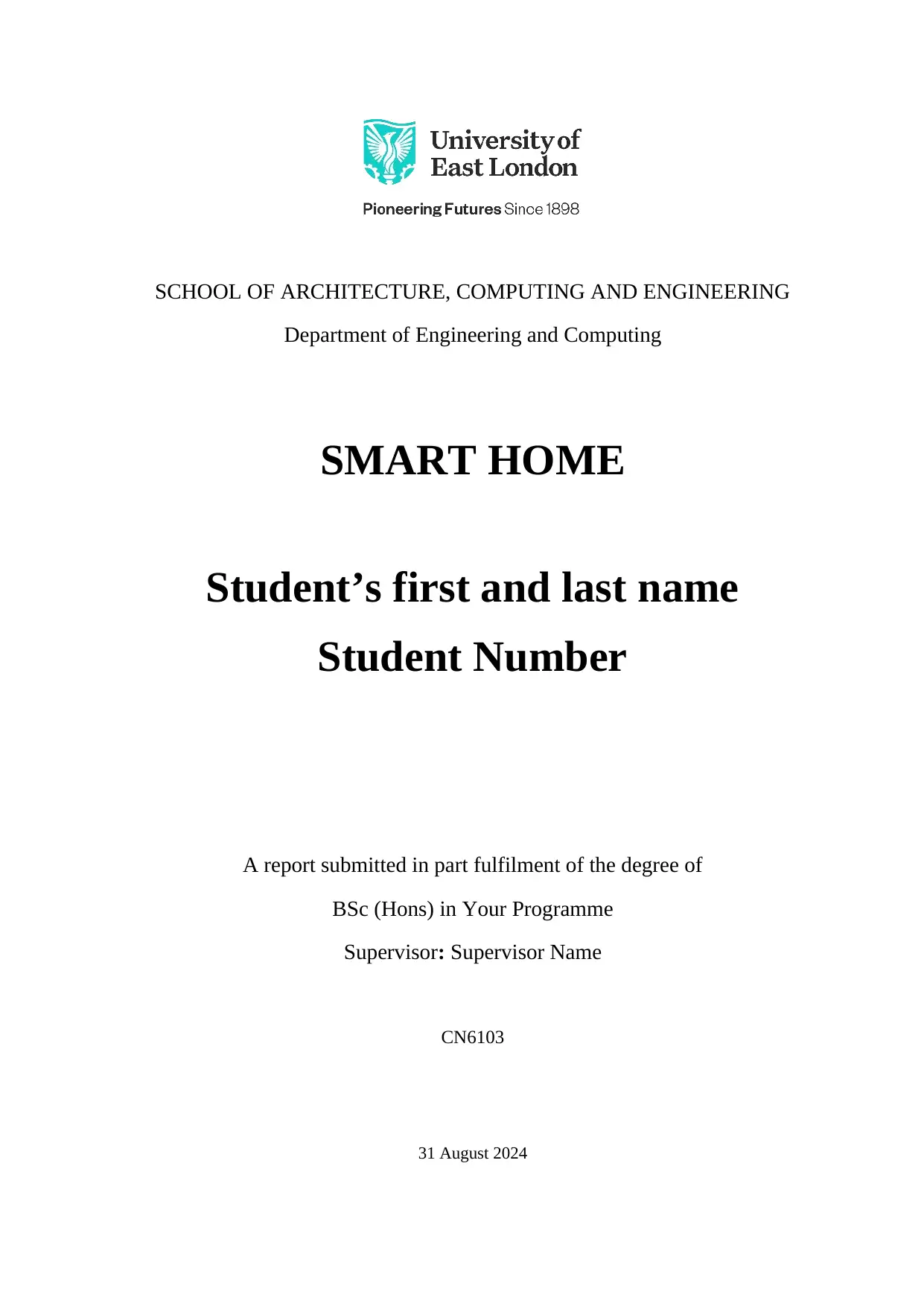
SCHOOL OF ARCHITECTURE, COMPUTING AND ENGINEERING
Department of Engineering and Computing
SMART HOME
Student’s first and last name
Student Number
A report submitted in part fulfilment of the degree of
BSc (Hons) in Your Programme
Supervisor: Supervisor Name
CN6103
31 August 2024
Department of Engineering and Computing
SMART HOME
Student’s first and last name
Student Number
A report submitted in part fulfilment of the degree of
BSc (Hons) in Your Programme
Supervisor: Supervisor Name
CN6103
31 August 2024
Paraphrase This Document
Need a fresh take? Get an instant paraphrase of this document with our AI Paraphraser

Declaration
I, hereby declare that the work presented is original and has never been submitted for an award to
any university or institution of higher learning. I can confirm that where I have done consultations
either from published material or the works of others, it has been attributed in this report.
I, hereby declare that the work presented is original and has never been submitted for an award to
any university or institution of higher learning. I can confirm that where I have done consultations
either from published material or the works of others, it has been attributed in this report.

Approval
This project report titled Smart Home Application has been submitted for examination with my
approval as the supervisor
Signature: ................................................... Date: ............................
Supervisor.
This project report titled Smart Home Application has been submitted for examination with my
approval as the supervisor
Signature: ................................................... Date: ............................
Supervisor.
⊘ This is a preview!⊘
Do you want full access?
Subscribe today to unlock all pages.

Trusted by 1+ million students worldwide

Acknowledgements
To the Almighty God, we thank Him for the love, affection and mercy He had for us throughout the
implementation of our final year project up to the time of producing this report.
My heartfelt gratitude goes to my supervisors; ---------------- who have been very instrumental in
this project by selflessly providing their time, expert advice and guidance that has enabled me
complete this project.
The support of family and friends during the period when carrying out this project cannot be left
unsaid. Our parents most especially have been so amazing during this period. To all other family
members and friends, words cannot fully express my gratitude to you but we sincerely appreciate
you for what you have been to us throughout the whole period of my career development.
I also sincerely grateful to our project team members for their dedication, hard work and
cooperation throughout the entire academic year to see this project to completion.
To the Almighty God, we thank Him for the love, affection and mercy He had for us throughout the
implementation of our final year project up to the time of producing this report.
My heartfelt gratitude goes to my supervisors; ---------------- who have been very instrumental in
this project by selflessly providing their time, expert advice and guidance that has enabled me
complete this project.
The support of family and friends during the period when carrying out this project cannot be left
unsaid. Our parents most especially have been so amazing during this period. To all other family
members and friends, words cannot fully express my gratitude to you but we sincerely appreciate
you for what you have been to us throughout the whole period of my career development.
I also sincerely grateful to our project team members for their dedication, hard work and
cooperation throughout the entire academic year to see this project to completion.
Paraphrase This Document
Need a fresh take? Get an instant paraphrase of this document with our AI Paraphraser
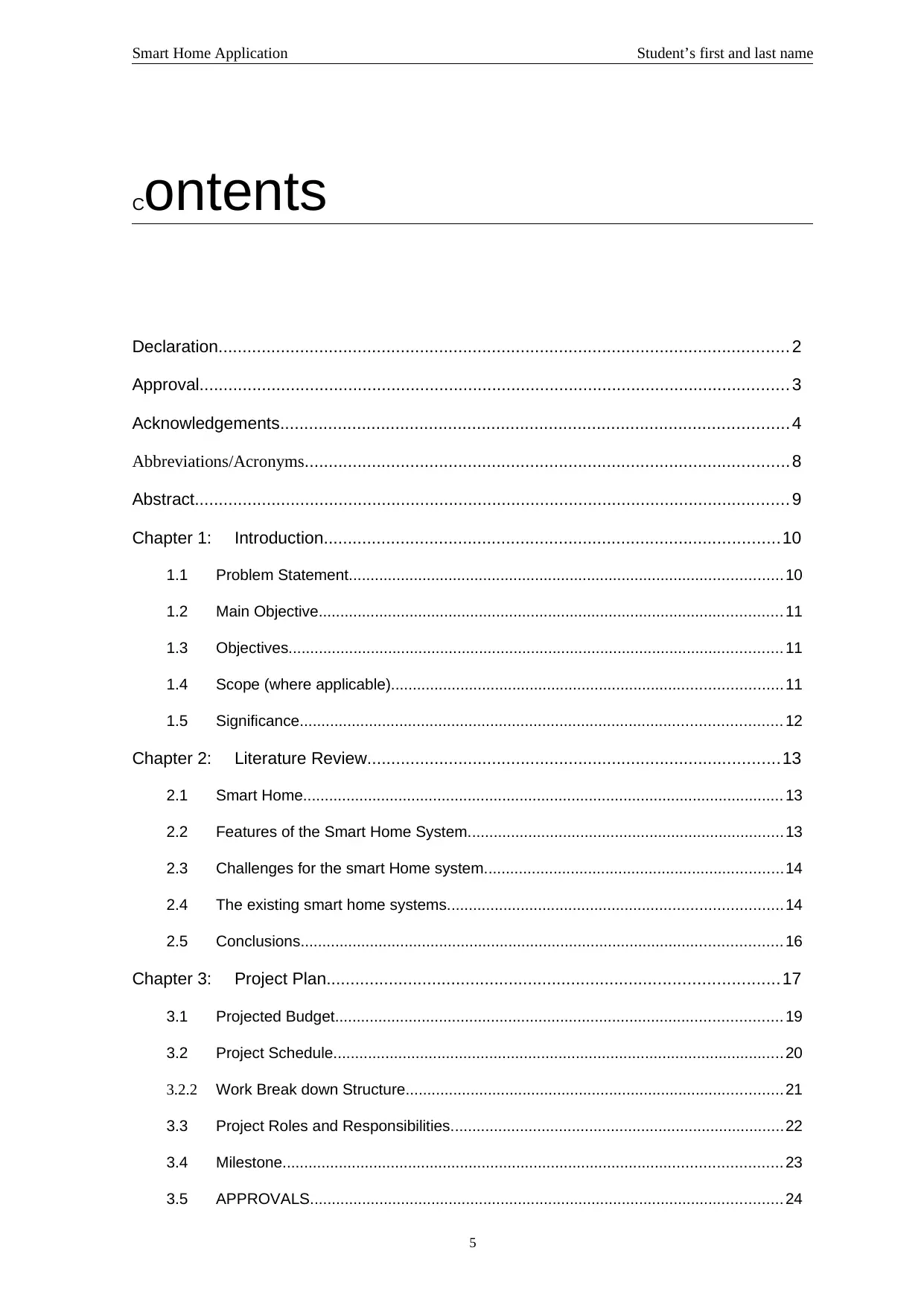
Smart Home Application Student’s first and last name
Contents
Declaration....................................................................................................................... 2
Approval........................................................................................................................... 3
Acknowledgements..........................................................................................................4
Abbreviations/Acronyms.....................................................................................................8
Abstract............................................................................................................................ 9
Chapter 1: Introduction...............................................................................................10
1.1 Problem Statement....................................................................................................10
1.2 Main Objective........................................................................................................... 11
1.3 Objectives.................................................................................................................. 11
1.4 Scope (where applicable)..........................................................................................11
1.5 Significance............................................................................................................... 12
Chapter 2: Literature Review......................................................................................13
2.1 Smart Home............................................................................................................... 13
2.2 Features of the Smart Home System.........................................................................13
2.3 Challenges for the smart Home system.....................................................................14
2.4 The existing smart home systems.............................................................................14
2.5 Conclusions............................................................................................................... 16
Chapter 3: Project Plan..............................................................................................17
3.1 Projected Budget....................................................................................................... 19
3.2 Project Schedule........................................................................................................ 20
3.2.2 Work Break down Structure.......................................................................................21
3.3 Project Roles and Responsibilities.............................................................................22
3.4 Milestone................................................................................................................... 23
3.5 APPROVALS............................................................................................................. 24
5
Contents
Declaration....................................................................................................................... 2
Approval........................................................................................................................... 3
Acknowledgements..........................................................................................................4
Abbreviations/Acronyms.....................................................................................................8
Abstract............................................................................................................................ 9
Chapter 1: Introduction...............................................................................................10
1.1 Problem Statement....................................................................................................10
1.2 Main Objective........................................................................................................... 11
1.3 Objectives.................................................................................................................. 11
1.4 Scope (where applicable)..........................................................................................11
1.5 Significance............................................................................................................... 12
Chapter 2: Literature Review......................................................................................13
2.1 Smart Home............................................................................................................... 13
2.2 Features of the Smart Home System.........................................................................13
2.3 Challenges for the smart Home system.....................................................................14
2.4 The existing smart home systems.............................................................................14
2.5 Conclusions............................................................................................................... 16
Chapter 3: Project Plan..............................................................................................17
3.1 Projected Budget....................................................................................................... 19
3.2 Project Schedule........................................................................................................ 20
3.2.2 Work Break down Structure.......................................................................................21
3.3 Project Roles and Responsibilities.............................................................................22
3.4 Milestone................................................................................................................... 23
3.5 APPROVALS............................................................................................................. 24
5
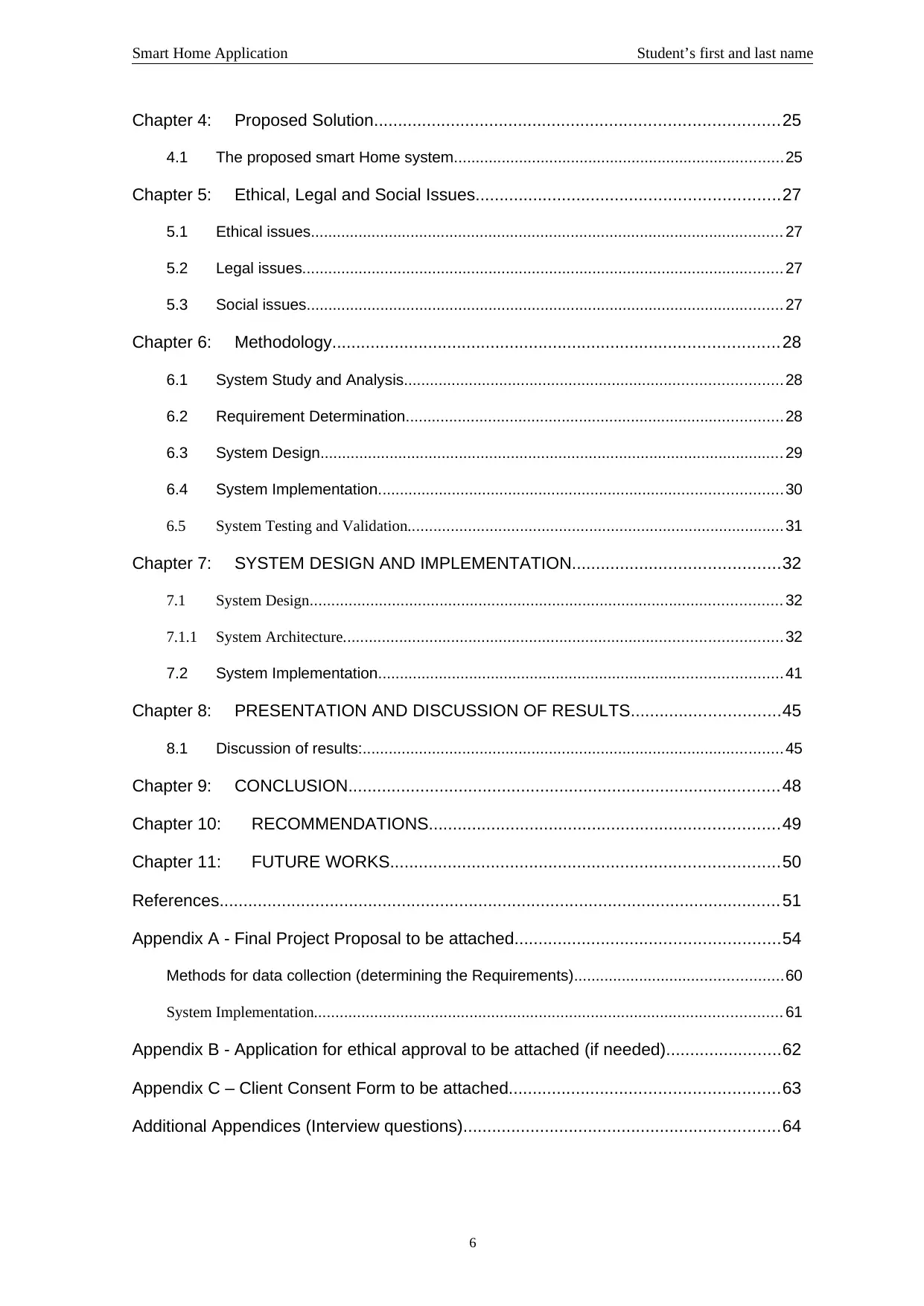
Smart Home Application Student’s first and last name
Chapter 4: Proposed Solution....................................................................................25
4.1 The proposed smart Home system............................................................................25
Chapter 5: Ethical, Legal and Social Issues...............................................................27
5.1 Ethical issues............................................................................................................. 27
5.2 Legal issues............................................................................................................... 27
5.3 Social issues.............................................................................................................. 27
Chapter 6: Methodology.............................................................................................28
6.1 System Study and Analysis.......................................................................................28
6.2 Requirement Determination.......................................................................................28
6.3 System Design........................................................................................................... 29
6.4 System Implementation.............................................................................................30
6.5 System Testing and Validation.......................................................................................31
Chapter 7: SYSTEM DESIGN AND IMPLEMENTATION...........................................32
7.1 System Design............................................................................................................. 32
7.1.1 System Architecture..................................................................................................... 32
7.2 System Implementation.............................................................................................41
Chapter 8: PRESENTATION AND DISCUSSION OF RESULTS...............................45
8.1 Discussion of results:.................................................................................................45
Chapter 9: CONCLUSION..........................................................................................48
Chapter 10: RECOMMENDATIONS.........................................................................49
Chapter 11: FUTURE WORKS.................................................................................50
References.....................................................................................................................51
Appendix A - Final Project Proposal to be attached.......................................................54
Methods for data collection (determining the Requirements)................................................60
System Implementation............................................................................................................ 61
Appendix B - Application for ethical approval to be attached (if needed)........................62
Appendix C – Client Consent Form to be attached........................................................63
Additional Appendices (Interview questions)..................................................................64
6
Chapter 4: Proposed Solution....................................................................................25
4.1 The proposed smart Home system............................................................................25
Chapter 5: Ethical, Legal and Social Issues...............................................................27
5.1 Ethical issues............................................................................................................. 27
5.2 Legal issues............................................................................................................... 27
5.3 Social issues.............................................................................................................. 27
Chapter 6: Methodology.............................................................................................28
6.1 System Study and Analysis.......................................................................................28
6.2 Requirement Determination.......................................................................................28
6.3 System Design........................................................................................................... 29
6.4 System Implementation.............................................................................................30
6.5 System Testing and Validation.......................................................................................31
Chapter 7: SYSTEM DESIGN AND IMPLEMENTATION...........................................32
7.1 System Design............................................................................................................. 32
7.1.1 System Architecture..................................................................................................... 32
7.2 System Implementation.............................................................................................41
Chapter 8: PRESENTATION AND DISCUSSION OF RESULTS...............................45
8.1 Discussion of results:.................................................................................................45
Chapter 9: CONCLUSION..........................................................................................48
Chapter 10: RECOMMENDATIONS.........................................................................49
Chapter 11: FUTURE WORKS.................................................................................50
References.....................................................................................................................51
Appendix A - Final Project Proposal to be attached.......................................................54
Methods for data collection (determining the Requirements)................................................60
System Implementation............................................................................................................ 61
Appendix B - Application for ethical approval to be attached (if needed)........................62
Appendix C – Client Consent Form to be attached........................................................63
Additional Appendices (Interview questions)..................................................................64
6
⊘ This is a preview!⊘
Do you want full access?
Subscribe today to unlock all pages.

Trusted by 1+ million students worldwide
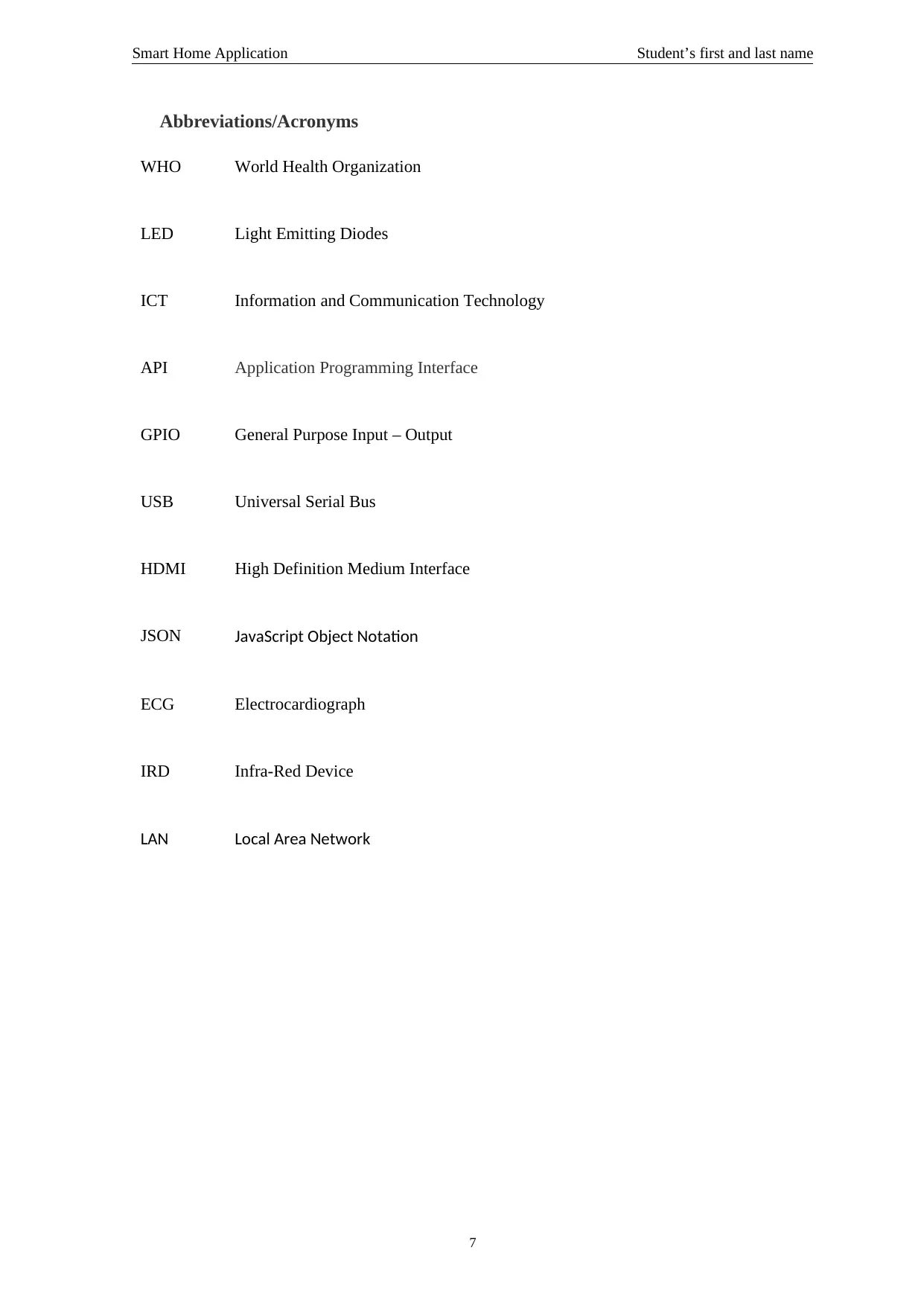
Smart Home Application Student’s first and last name
Abbreviations/Acronyms
WHO World Health Organization
LED Light Emitting Diodes
ICT Information and Communication Technology
API Application Programming Interface
GPIO General Purpose Input – Output
USB Universal Serial Bus
HDMI High Definition Medium Interface
JSON JavaScript Object Notation
ECG Electrocardiograph
IRD Infra-Red Device
LAN Local Area Network
7
Abbreviations/Acronyms
WHO World Health Organization
LED Light Emitting Diodes
ICT Information and Communication Technology
API Application Programming Interface
GPIO General Purpose Input – Output
USB Universal Serial Bus
HDMI High Definition Medium Interface
JSON JavaScript Object Notation
ECG Electrocardiograph
IRD Infra-Red Device
LAN Local Area Network
7
Paraphrase This Document
Need a fresh take? Get an instant paraphrase of this document with our AI Paraphraser
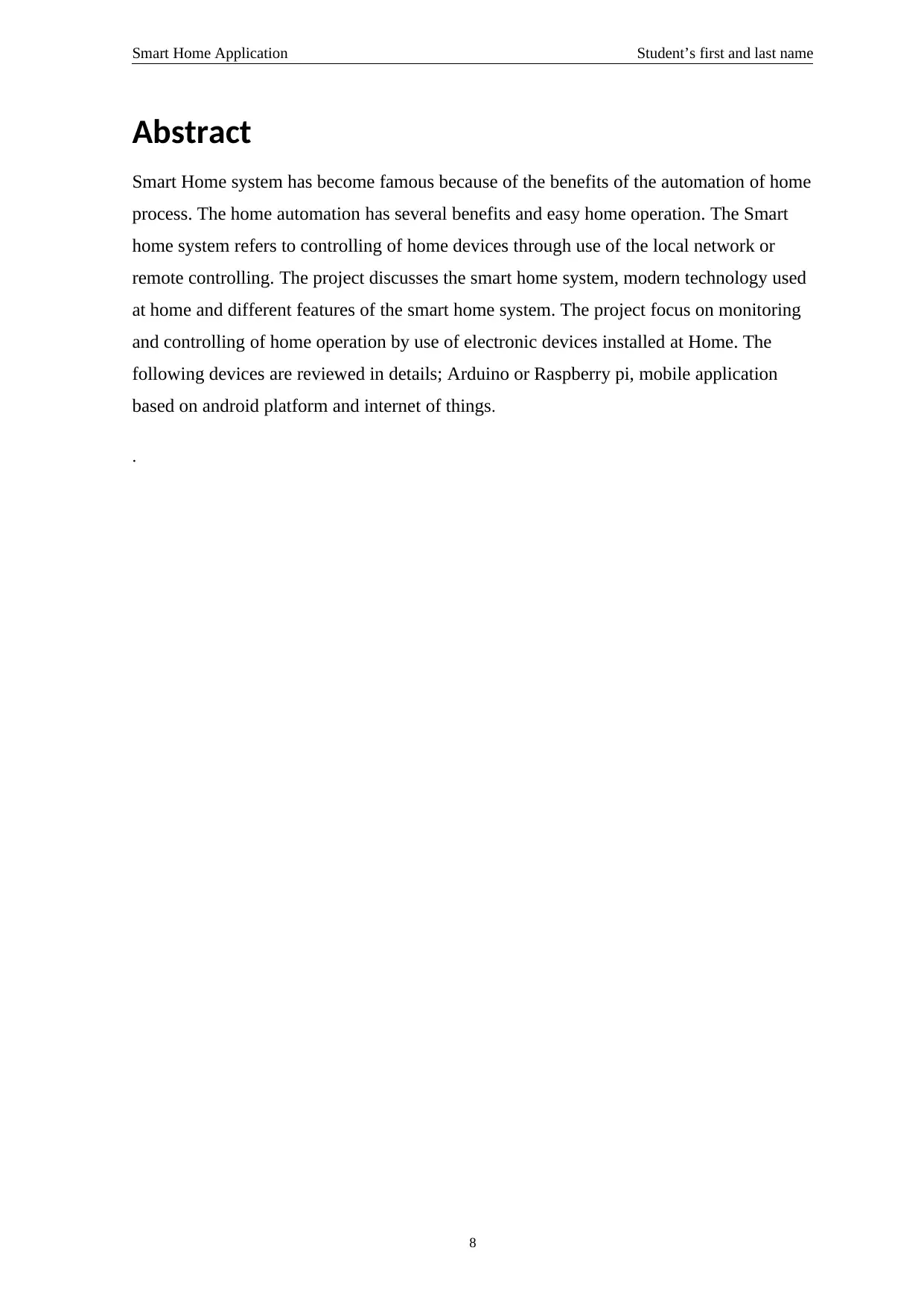
Smart Home Application Student’s first and last name
Abstract
Smart Home system has become famous because of the benefits of the automation of home
process. The home automation has several benefits and easy home operation. The Smart
home system refers to controlling of home devices through use of the local network or
remote controlling. The project discusses the smart home system, modern technology used
at home and different features of the smart home system. The project focus on monitoring
and controlling of home operation by use of electronic devices installed at Home. The
following devices are reviewed in details; Arduino or Raspberry pi, mobile application
based on android platform and internet of things.
.
8
Abstract
Smart Home system has become famous because of the benefits of the automation of home
process. The home automation has several benefits and easy home operation. The Smart
home system refers to controlling of home devices through use of the local network or
remote controlling. The project discusses the smart home system, modern technology used
at home and different features of the smart home system. The project focus on monitoring
and controlling of home operation by use of electronic devices installed at Home. The
following devices are reviewed in details; Arduino or Raspberry pi, mobile application
based on android platform and internet of things.
.
8
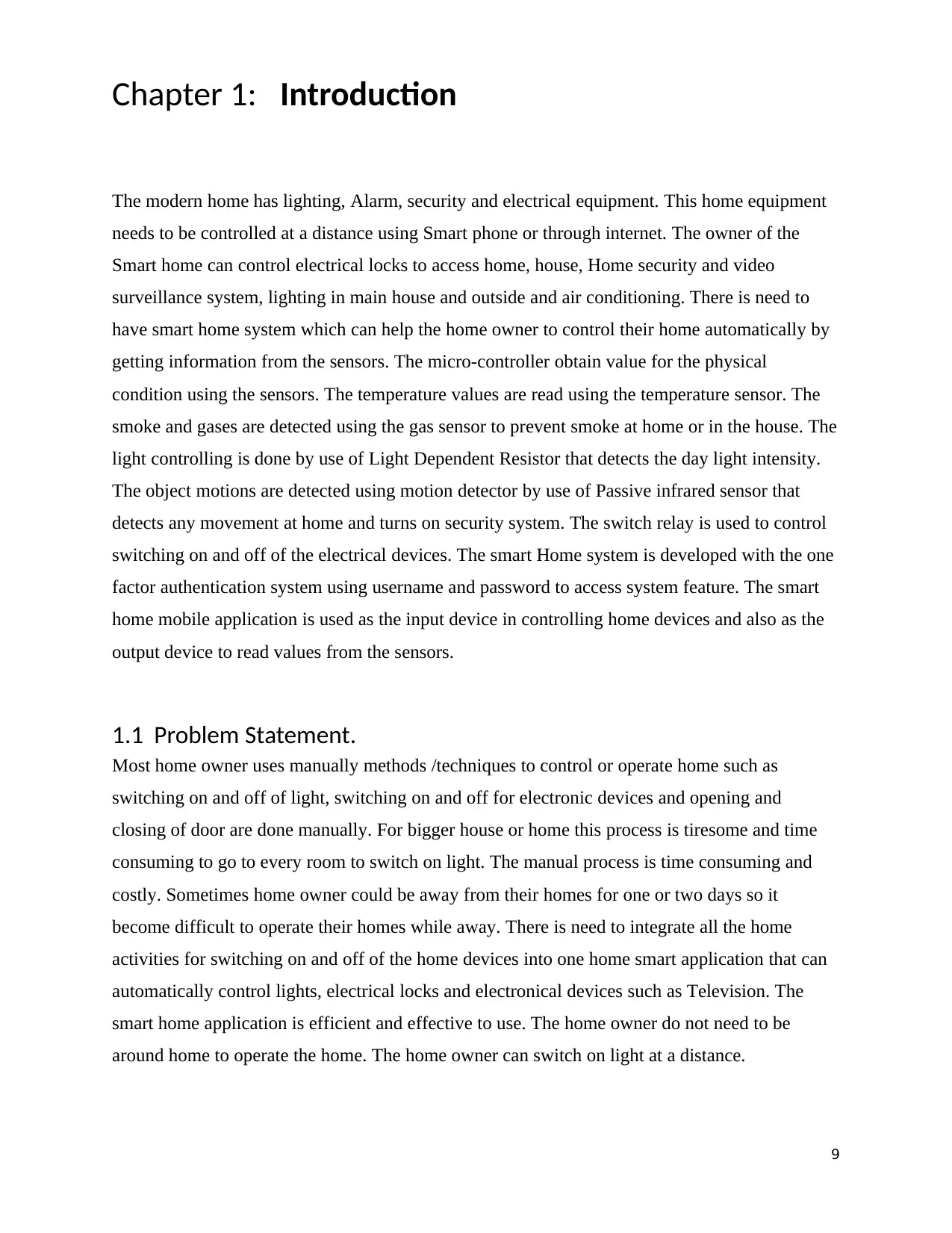
Chapter 1: Introduction
The modern home has lighting, Alarm, security and electrical equipment. This home equipment
needs to be controlled at a distance using Smart phone or through internet. The owner of the
Smart home can control electrical locks to access home, house, Home security and video
surveillance system, lighting in main house and outside and air conditioning. There is need to
have smart home system which can help the home owner to control their home automatically by
getting information from the sensors. The micro-controller obtain value for the physical
condition using the sensors. The temperature values are read using the temperature sensor. The
smoke and gases are detected using the gas sensor to prevent smoke at home or in the house. The
light controlling is done by use of Light Dependent Resistor that detects the day light intensity.
The object motions are detected using motion detector by use of Passive infrared sensor that
detects any movement at home and turns on security system. The switch relay is used to control
switching on and off of the electrical devices. The smart Home system is developed with the one
factor authentication system using username and password to access system feature. The smart
home mobile application is used as the input device in controlling home devices and also as the
output device to read values from the sensors.
1.1 Problem Statement.
Most home owner uses manually methods /techniques to control or operate home such as
switching on and off of light, switching on and off for electronic devices and opening and
closing of door are done manually. For bigger house or home this process is tiresome and time
consuming to go to every room to switch on light. The manual process is time consuming and
costly. Sometimes home owner could be away from their homes for one or two days so it
become difficult to operate their homes while away. There is need to integrate all the home
activities for switching on and off of the home devices into one home smart application that can
automatically control lights, electrical locks and electronical devices such as Television. The
smart home application is efficient and effective to use. The home owner do not need to be
around home to operate the home. The home owner can switch on light at a distance.
9
The modern home has lighting, Alarm, security and electrical equipment. This home equipment
needs to be controlled at a distance using Smart phone or through internet. The owner of the
Smart home can control electrical locks to access home, house, Home security and video
surveillance system, lighting in main house and outside and air conditioning. There is need to
have smart home system which can help the home owner to control their home automatically by
getting information from the sensors. The micro-controller obtain value for the physical
condition using the sensors. The temperature values are read using the temperature sensor. The
smoke and gases are detected using the gas sensor to prevent smoke at home or in the house. The
light controlling is done by use of Light Dependent Resistor that detects the day light intensity.
The object motions are detected using motion detector by use of Passive infrared sensor that
detects any movement at home and turns on security system. The switch relay is used to control
switching on and off of the electrical devices. The smart Home system is developed with the one
factor authentication system using username and password to access system feature. The smart
home mobile application is used as the input device in controlling home devices and also as the
output device to read values from the sensors.
1.1 Problem Statement.
Most home owner uses manually methods /techniques to control or operate home such as
switching on and off of light, switching on and off for electronic devices and opening and
closing of door are done manually. For bigger house or home this process is tiresome and time
consuming to go to every room to switch on light. The manual process is time consuming and
costly. Sometimes home owner could be away from their homes for one or two days so it
become difficult to operate their homes while away. There is need to integrate all the home
activities for switching on and off of the home devices into one home smart application that can
automatically control lights, electrical locks and electronical devices such as Television. The
smart home application is efficient and effective to use. The home owner do not need to be
around home to operate the home. The home owner can switch on light at a distance.
9
⊘ This is a preview!⊘
Do you want full access?
Subscribe today to unlock all pages.

Trusted by 1+ million students worldwide
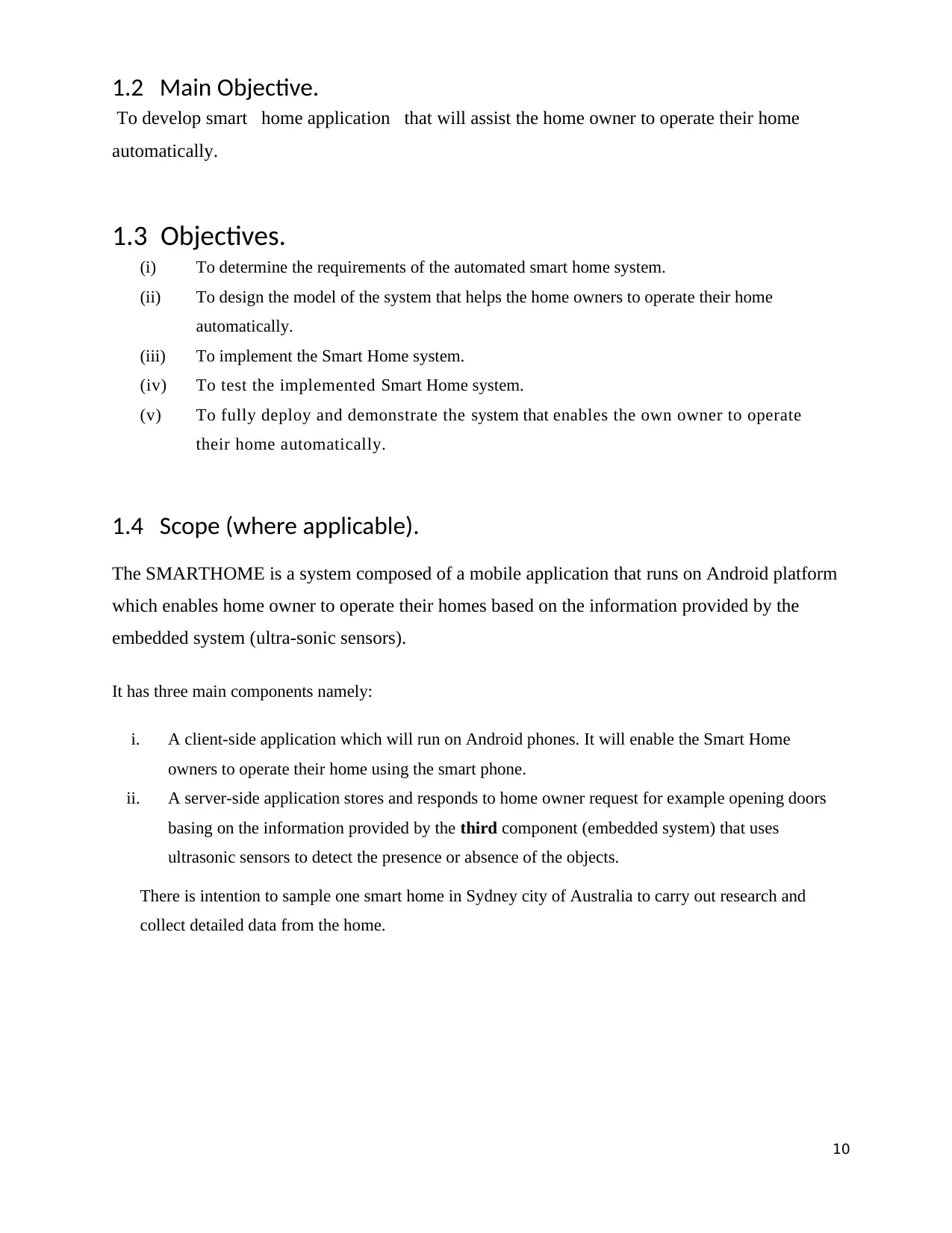
1.2 Main Objective.
To develop smart home application that will assist the home owner to operate their home
automatically.
1.3 Objectives.
(i) To determine the requirements of the automated smart home system.
(ii) To design the model of the system that helps the home owners to operate their home
automatically.
(iii) To implement the Smart Home system.
(iv) To test the implemented Smart Home system.
(v) To fully deploy and demonstrate the system that enables the own owner to operate
their home automatically.
1.4 Scope (where applicable).
The SMARTHOME is a system composed of a mobile application that runs on Android platform
which enables home owner to operate their homes based on the information provided by the
embedded system (ultra-sonic sensors).
It has three main components namely:
i. A client-side application which will run on Android phones. It will enable the Smart Home
owners to operate their home using the smart phone.
ii. A server-side application stores and responds to home owner request for example opening doors
basing on the information provided by the third component (embedded system) that uses
ultrasonic sensors to detect the presence or absence of the objects.
There is intention to sample one smart home in Sydney city of Australia to carry out research and
collect detailed data from the home.
10
To develop smart home application that will assist the home owner to operate their home
automatically.
1.3 Objectives.
(i) To determine the requirements of the automated smart home system.
(ii) To design the model of the system that helps the home owners to operate their home
automatically.
(iii) To implement the Smart Home system.
(iv) To test the implemented Smart Home system.
(v) To fully deploy and demonstrate the system that enables the own owner to operate
their home automatically.
1.4 Scope (where applicable).
The SMARTHOME is a system composed of a mobile application that runs on Android platform
which enables home owner to operate their homes based on the information provided by the
embedded system (ultra-sonic sensors).
It has three main components namely:
i. A client-side application which will run on Android phones. It will enable the Smart Home
owners to operate their home using the smart phone.
ii. A server-side application stores and responds to home owner request for example opening doors
basing on the information provided by the third component (embedded system) that uses
ultrasonic sensors to detect the presence or absence of the objects.
There is intention to sample one smart home in Sydney city of Australia to carry out research and
collect detailed data from the home.
10
Paraphrase This Document
Need a fresh take? Get an instant paraphrase of this document with our AI Paraphraser
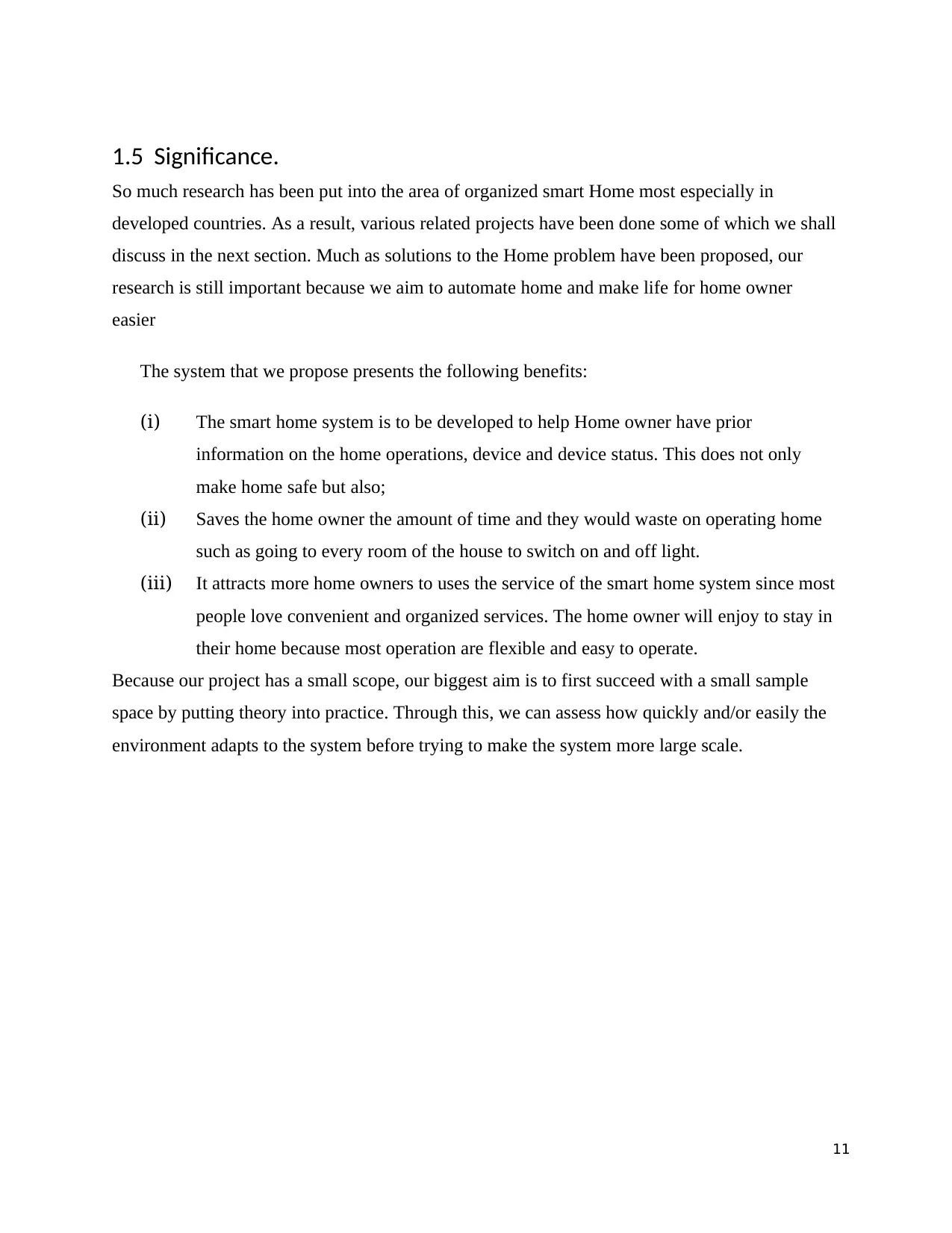
1.5 Significance.
So much research has been put into the area of organized smart Home most especially in
developed countries. As a result, various related projects have been done some of which we shall
discuss in the next section. Much as solutions to the Home problem have been proposed, our
research is still important because we aim to automate home and make life for home owner
easier
The system that we propose presents the following benefits:
(i) The smart home system is to be developed to help Home owner have prior
information on the home operations, device and device status. This does not only
make home safe but also;
(ii) Saves the home owner the amount of time and they would waste on operating home
such as going to every room of the house to switch on and off light.
(iii) It attracts more home owners to uses the service of the smart home system since most
people love convenient and organized services. The home owner will enjoy to stay in
their home because most operation are flexible and easy to operate.
Because our project has a small scope, our biggest aim is to first succeed with a small sample
space by putting theory into practice. Through this, we can assess how quickly and/or easily the
environment adapts to the system before trying to make the system more large scale.
11
So much research has been put into the area of organized smart Home most especially in
developed countries. As a result, various related projects have been done some of which we shall
discuss in the next section. Much as solutions to the Home problem have been proposed, our
research is still important because we aim to automate home and make life for home owner
easier
The system that we propose presents the following benefits:
(i) The smart home system is to be developed to help Home owner have prior
information on the home operations, device and device status. This does not only
make home safe but also;
(ii) Saves the home owner the amount of time and they would waste on operating home
such as going to every room of the house to switch on and off light.
(iii) It attracts more home owners to uses the service of the smart home system since most
people love convenient and organized services. The home owner will enjoy to stay in
their home because most operation are flexible and easy to operate.
Because our project has a small scope, our biggest aim is to first succeed with a small sample
space by putting theory into practice. Through this, we can assess how quickly and/or easily the
environment adapts to the system before trying to make the system more large scale.
11
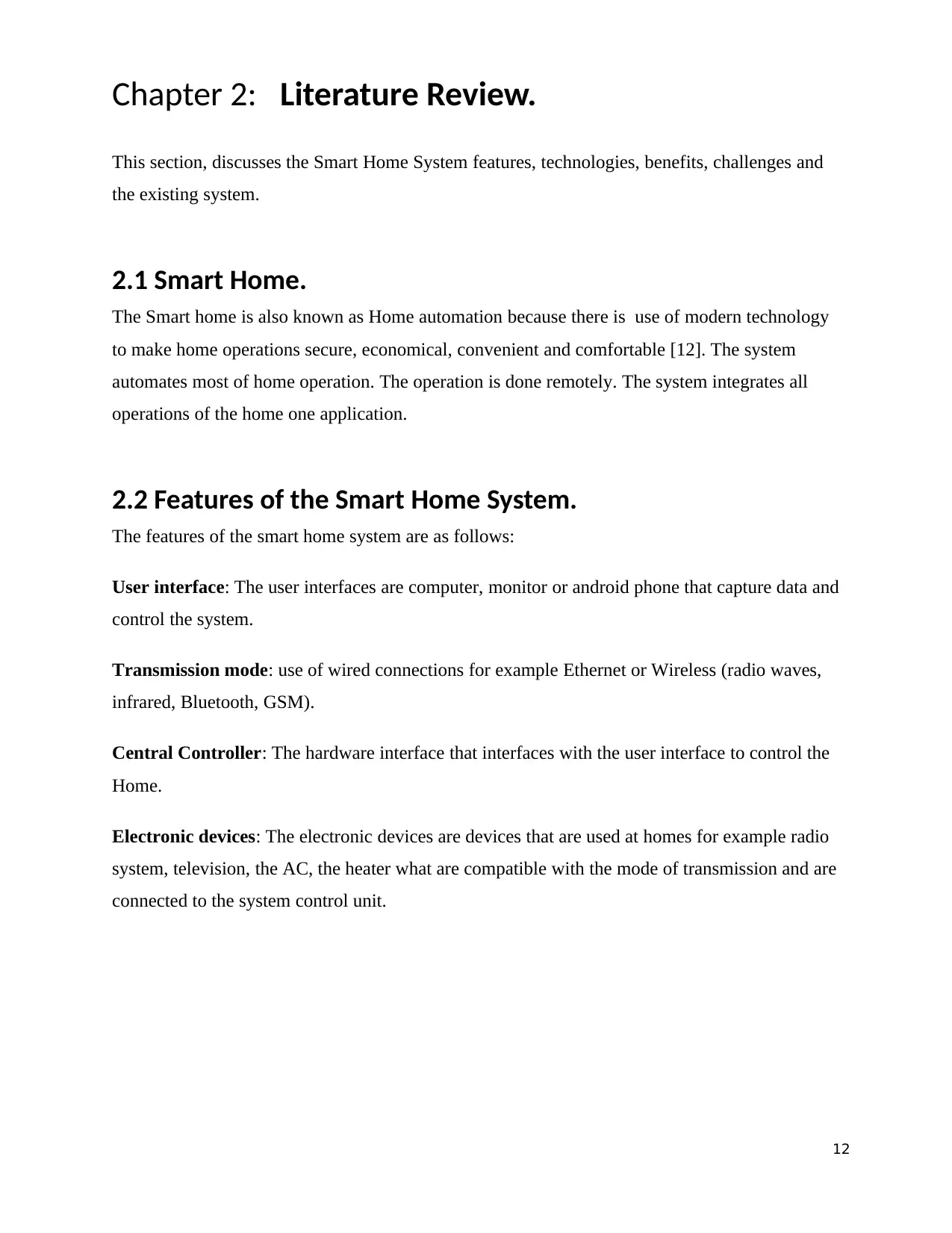
Chapter 2: Literature Review.
This section, discusses the Smart Home System features, technologies, benefits, challenges and
the existing system.
2.1 Smart Home.
The Smart home is also known as Home automation because there is use of modern technology
to make home operations secure, economical, convenient and comfortable [12]. The system
automates most of home operation. The operation is done remotely. The system integrates all
operations of the home one application.
2.2 Features of the Smart Home System.
The features of the smart home system are as follows:
User interface: The user interfaces are computer, monitor or android phone that capture data and
control the system.
Transmission mode: use of wired connections for example Ethernet or Wireless (radio waves,
infrared, Bluetooth, GSM).
Central Controller: The hardware interface that interfaces with the user interface to control the
Home.
Electronic devices: The electronic devices are devices that are used at homes for example radio
system, television, the AC, the heater what are compatible with the mode of transmission and are
connected to the system control unit.
12
This section, discusses the Smart Home System features, technologies, benefits, challenges and
the existing system.
2.1 Smart Home.
The Smart home is also known as Home automation because there is use of modern technology
to make home operations secure, economical, convenient and comfortable [12]. The system
automates most of home operation. The operation is done remotely. The system integrates all
operations of the home one application.
2.2 Features of the Smart Home System.
The features of the smart home system are as follows:
User interface: The user interfaces are computer, monitor or android phone that capture data and
control the system.
Transmission mode: use of wired connections for example Ethernet or Wireless (radio waves,
infrared, Bluetooth, GSM).
Central Controller: The hardware interface that interfaces with the user interface to control the
Home.
Electronic devices: The electronic devices are devices that are used at homes for example radio
system, television, the AC, the heater what are compatible with the mode of transmission and are
connected to the system control unit.
12
⊘ This is a preview!⊘
Do you want full access?
Subscribe today to unlock all pages.

Trusted by 1+ million students worldwide
1 out of 63
Related Documents
Your All-in-One AI-Powered Toolkit for Academic Success.
+13062052269
info@desklib.com
Available 24*7 on WhatsApp / Email
![[object Object]](/_next/static/media/star-bottom.7253800d.svg)
Unlock your academic potential
Copyright © 2020–2025 A2Z Services. All Rights Reserved. Developed and managed by ZUCOL.





